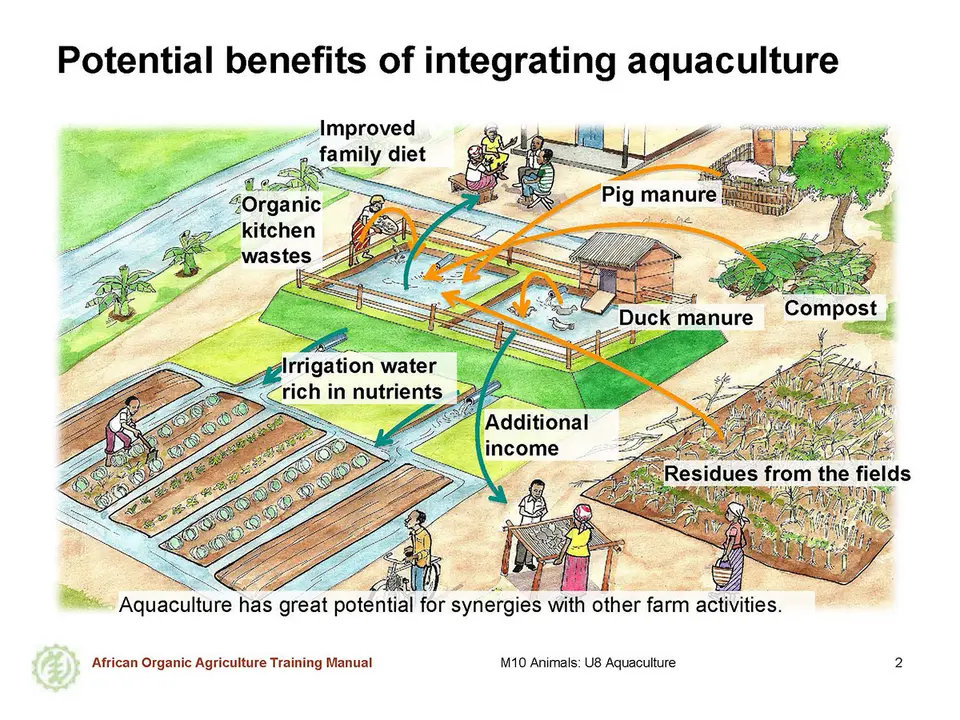Proper integration of aquaculture into the farming system
Proper integration of aquaculture into the farming systems is the primary aim in organic aquaculture in order to ensure sustainable production. Besides this, other aims of organic aquaculture include:
- producing fish with minimal negative effects on the environment;
- producing fish that contain as low as possible levels of contaminants and chemical residues;
- raising fish while paying special attention to respecting animal care and welfare;
- feeding the fish without competing with human beings for food;
- contributing to farmer families’ daily menu at low cost and moderate effort;
- entering markets and offering an attractive healthy foodstuff; and
- contributing to social development by gaining premiums that could be reinvested in the community.
Organic aquaculture relies on organic cycles, first of all on a healthy environment consisting of good quality water. The fish is raised on natural feed production, preferably farm-own by-products, homemade feeds or certified organic feeds.
The culture of Tilapia nilotica in ponds, fed on pelleted feeds made from locally available agricultural and industrial waste products, yielding three crops and a production of not less than 5,000 kg per hectare and year, has already been tested and found to be perfectly feasible and economical in Central African countries. When combined with duck or pig production, the income of the farmer increases two to three times. Experimental culture of grey mullets (Mugil spp.), tilapia (Tilapia spp.) and catfish (Clarias lazera) or common carp (Cyprinus carpio) in brackish water ponds in deltaic areas in Nigeria and Egypt producing about 3.500 kg per hectare, has served to show the feasibility of brackish water farming. Rice field carp culture is an established practice in Madagascar. Stocking of small dams and reservoirs with tilapia has yielded very encouraging results in Kenya and Ghana.
Note for the trainer:
For reasons of simplification, this training guide only refers to growing the most popular tilapia species Oreochromis niloticus, the Nile tilapia, in ponds. This species is easy to manage and is omnivorous, meaning it feeds on both plant and animal material such as algae and microalgae as well as on zooplankton, small crustaceans
Key requirements for growing fish in a pond
Digging a hole in the ground, filling it with water and throwing some fish into it will not alone lead to success. To be successful, pond fish farming requires proper planning before starting.
- Land and labour - Before starting, the land and labour costs need to be estimated, for example, for buying or renting the land to build the ponds on, for labour for digging the ponds, for management and for harvesting of the fish. Other costs may include buying the fish stock and feeds.
- Suitable site - Growing the fish in a pond requires enough water of good quality and at reasonable costs. If any permits are required to use the water, they must be obtained first. The soil at the site must be able to retain water.
- Fish stock - Future fish farmers need to decide whether to breed their own fish stock or to purchase it from other farmers. When purchasing the young fish from other sources, the farmer must be sure of having a reliable source of good quality fish. If he plans to certify his fish as organic, the fish shall not be modified in its genes and not treated with hormones. Both treatments are often done to obtain just male fish, and are common with tilapia. If the farmer instead chooses to breed own fish on his own farm, then sufficient space is needed to maintain production of brood stock (parent fish) and young fish (fingerlings).
- Market for the fish - If a farmer decides to produce fish for the nearby markets, he must be sure that his product is attractive for the shops and the buyers. And he needs to be sure that the prices he will get are reasonable enough to at least cover his production costs.
- Proper management - In contrast to a fisherman, a fish farmer is responsible for the growth of the fish from young stages until it reaches market size. This means that the fish farmer needs to care for the fish and its growing environment – very similar to a farmer keeping chickens or cows. Fish farming requires spare time for monitoring several times a day.
Discussion on local potential of growing fish in ponds
Invite the farmers to discuss about the potential of pond farming in local context.
- Can the cultivation of fish upgrade local farms?
- Are the natural, social and financial circumstances favourable to fish farming?
- Does market demand encourage uptake of this new farm activity?
- Are there any constraints to this new activity?

 tap and then scroll down to the Add to Home Screen command.
tap and then scroll down to the Add to Home Screen command.